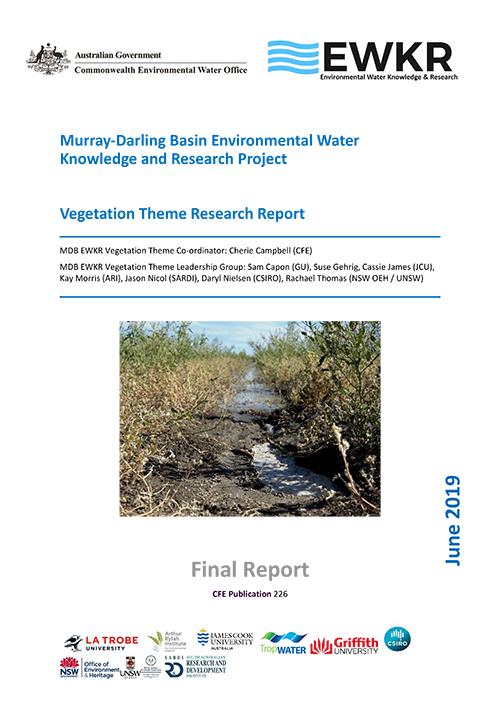
Theme Coordinator: Cherie Campbell
Unique, diverse and complex: The ever-changing face of wetland plants
Wetland plants are critical components of both aquatic and terrestrial ecosystems. They provide habitat for a large array of animals and support a range of functions. Basin-scale monitoring and research projects are providing insights into just how diverse, unique and complex these wetland plant communities are at a landscape scale.Floodplain wetlands in the Murray-Darling Basin support a tremendous diversity of plants and structural habitats. The majority of wetland plants are annual or short-lived perennial species which respond to environmental and seasonal conditions. The composition and structural complexity of understory plant communities within floodplain wetlands is continually changing in response to the availability of surface water, soil moisture and other environmental cues. This results in unique assemblages of plants across different wetlands at any given point in time.
While many wetland plant species are considered to be widely distributed and cosmopolitan, factors such as, but not limited to, location, dispersal of propagules, current availability of water, historical inundation regimes and canopy structure influence the expression of plant species to provide significant spatial and temporal heterogeneity at a Basin-scale. This heterogeneity maintains a diversity of habitat types which helps support a wide variety of functions and animals. Supporting habitat diversity at a landscape scale is one of the many uses of environmental water. Monitoring and research programs evaluate the outcomes of environmental flows and provide knowledge that underpins the process of efficient and effective delivery of environmental flows. Understanding and maintaining wetland diversity at a landscape scale is crucial to maintaining Basin-scale biodiversity.
Key outcomes:
For additional notes on each key outcome, please refer to the respective section numbers within the full report (provided further below).
- To achieve vegetation outcomes from environmental water a process of social, ecological and economic consideration is required (Section 1 and 2.1)
- What are we watering for and why? We provide structure and knowledge to help refine objectives, define function and value, and select indicators across a range of spatial and temporal scales to inform environmental watering (Section 2.1).
- Understory vegetation outcomes are diverse, both spatially and over time. The response of plant communities to watering actions, vary from place to place leading to a diversity of outcomes from the same watering treatments spatially. Across the Basin, the variation in response to the same watering actions, leads to a diversity of vegscapes (Section 2.2 and 2.3)
- Variability in vegetation responses are predicted to arise as a result of differences in location, recent flow conditions (e.g. water depth, time since last inundation, proportion time wet), vegetation structure, and medium to long term flow regimes (Section 2.2 and 2.3).
- Watering lignum once in every 1 – 3 years assists in greatest clump size which supports waterbird recruitment (Section 2.3).
- Woody recruitment is variable despite similarities in vegetation type and flooding frequency (Section 2.3).
- Eucalypt tree seedlings have different strategies to respond to watering treatments which reflect the distribution and likely inundation regime experienced by the species (Section 2.4).
- Constant inundation suppresses seedling growth, but may not lead to mortality (Section 2.4).
- Inter flood dry periods are important for seedling growth, particularly development of roots which are vital for anchorage, stability, access to groundwater and the ability to tolerate dry periods (Section 2.4).
- Coolibah and black box seedlings are sensitive to the timing of floods relative to their age, with both species performing better under a later flood as opposed to an earlier flood (Section 2.4).
To download the full report, click the button below.




